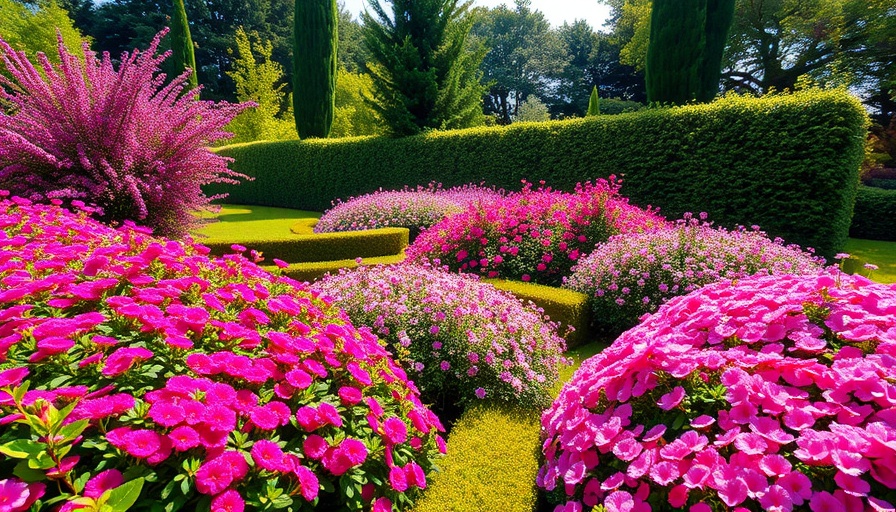
Unlocking the Beauty of Mass Planting: Creating Vibrant Floral Landscapes
Mass planting is an artistic and effective gardening technique that groups flowers together to create lush, vibrant displays. This method doesn’t simply fill space; it transforms gardens, offering visual appeal and functioning benefits for the ecosystem. By clustering flowers, you can effectively manage soil conditions, suppress weeds, and encourage healthy growth.
Understanding Mass Planting: A Guide to Fuller Spaces
What exactly is mass planting? This innovative approach to flower gardening involves arranging flowers in dense clusters, rather than spaced apart, to foster full coverage and a dramatic effect. This design can also minimize maintenance, as the densely packed flora helps cool the soil and reduce weed growth. Enhanced visual aesthetics can easily be achieved in both suburban and urban settings, allowing homeowners to create inviting spaces.
Choosing the Right Flowers for Maximum Impact
With so many varieties available, selecting the best flowers for mass planting can feel overwhelming. Here are twenty-one exceptional options:
- Astilbe - Perfect for shady spots, bringing feathery spires of color.
- Begonias - Vibrant shades complement garden corners beautifully.
- Black-Eyed Susans - Their cheerful, golden blooms draw in pollinators.
- Chrysanthemums - Offering seasonal cheer with their hardy blooms.
- Coneflowers - Not only beautiful but also attract beneficial insects.
- Cosmos - Delicate and airy, perfect for swaying in the breeze.
- Daffodils - Heralds of spring that brighten up any garden.
- Daylilies - Versatile and long-blooming for various settings.
- Dianthus - A colorful, low-maintenance choice.
- Geraniums - Ideal for container gardening as well as beds.
- Grape Hyacinths - Tiny but impactful, adding splashes of deep blue.
- Impatiens - Great for shaded areas, offering colorful options.
- Marigolds - Natural pest deterrents that also burst with color.
- Petunias - Versatile and perfect for hanging baskets or borders.
- Phlox - A summer staple with cascading blooms.
- Sedum - Succulents that add an interesting texture to displays.
- Snow-in-Summer - Its soft white flowers bring a fresh appearance.
- Sweet Alyssum - Fragrant and cheerful, they're eye-catching ground cover.
- Tulips - Timeless classics that bring joy in spring.
- Zinnias - Bold and bright, they provide continuous blooms.
The Benefits of Flower Groupings in Gardening
Mass planting not only enhances the aesthetic appeal of a garden; it also holds environmental advantages. When flowers are grouped closely, they create micro-climates that can be beneficial for insects and birds, supporting a diverse array of wildlife. Additionally, by carefully selecting flowers that bloom at different times, you create layers of seasonal interest, making your garden a year-round joy to observe.
Future Trends: The Evolving Art of Mass Planting
Looking ahead, eco-conscious gardening practices will further influence mass planting techniques. This includes selecting pest-resistant plants that require fewer inputs and embracing climate-friendly gardening practices. Grouping flowers will evolve into a sustainable art form, ensuring beauty without compromising the health of our ecosystems.
Actionable Tips for Successful Mass Planting
To effectively implement mass planting in your garden, consider the following tips:
- Choose a Palette: Decide on colors that complement each other, or mix annuals and perennials for variability.
- Plan the Layout: Before planting, sketch how you want your garden to unfold- consider heights, bloom times, and colors.
- Soil Preparation: Ensure your soil is nutrient-rich and well-aerated for the best flower growth.
- Watering Routine: Create a consistent watering schedule to establish healthy roots.
- Observe and Adapt: As seasons change, monitor which plants thrive and adjust future plantings accordingly.
Inspiring Community Through Gardening
Mass planting exemplifies how gardening can foster community spirit, as shared spaces filled with vibrant colors invite connection and engagement. By creating inviting gardens, we not only beautify our homes but also contribute positively to our neighborhoods, paying homage to both nature and community.
As you embark on your mass planting journey, you’ll find that gardening is much more than a hobby; it's a pathway to joy, self-discovery, and connection. Embrace this art and start synthesizing the beauty of nature in your very own spaces!
Call to Action: Composting and using the best garden fertilizers can greatly enhance your mass planting efforts. Explore reliable vendors and discover products that can turn your gardening dreams into reality!
 Add Row
Add Row  Add
Add 




 Add Row
Add Row  Add
Add 

Write A Comment